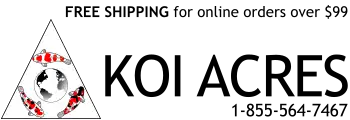Koi Pond Water Quality
Controlling water quality is essential to keeping your Koi healthy. This is done with filtration. The best way for controlling the toxins that Koi produce is by incorporating a biological filter into your pond.
Ammonia (NH3):
Koi, like any other animal, produce toxins. The main toxin that Koi produce is Ammonia. Koi excrete it through their gills and in their waste. If too much Ammonia builds up in your pond water, it will irritate your Koi's gills. Long term exposure to Ammonia will eventually start to harm their internal organs. Ammonia can be combated with biological filtration, chemical filtration, and large water changes.
Nitrite (NO2):
Nitrite is formed in the second stage of the Nitrogen Cycle. It isn't as toxic as Ammonia, but long term exposure can cause problems. Nitrite can make the hemoglobin in a Koi's blood to coagulate, literally "suffocating" it. Adding salt to your pond will combat this.
Nitrate (NO3):
Nitrate is a by-product of the Nitrogen Cycle. The bacteria, Nitrobacter, converts the toxic Nitrite into Nitrate. Nitrate can be removed with MASSIVE amounts of vegetation or with regular water changes.
pH (Potential of Hydrogen):
pH is the measure of free floating Hydrogen Ions in your water. The more free floating Hydrogen Ions you have in your water, the lower your pH will be. The more free floating Hydroxide Ions you have in your water, the higher your pH will be.
A pH level of seven is neutral. A level below seven makes your water acidic. A level above seven makes your water Alkaline. Koi can live comfortably in water with a pH range of 6.0 - 8.0.
Oxygen:
Koi need dissolved Oxygen in their water to live. A DO (Dissolved Oxygen) level of 5+ must be maintained. This can be done with an air pump/airstone, waterfall or a fountain. If the DO level drops below 5, you Koi will start to gasp at the surface and will eventually suffocate. In an emergency, Hydrogen Peroxide can be dumped into you pond to temporarily bring the DO level up.
